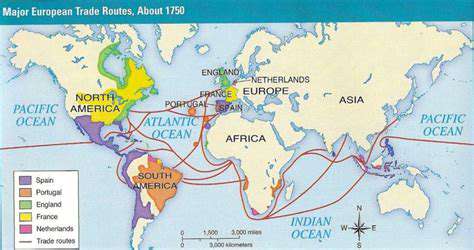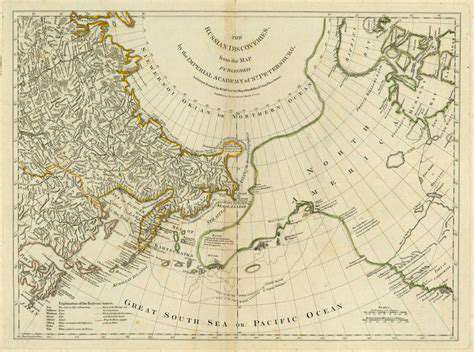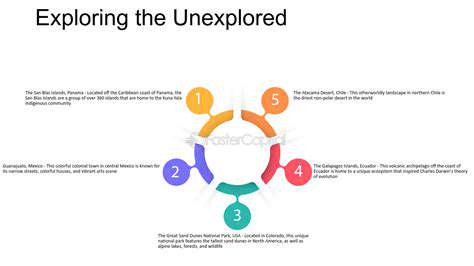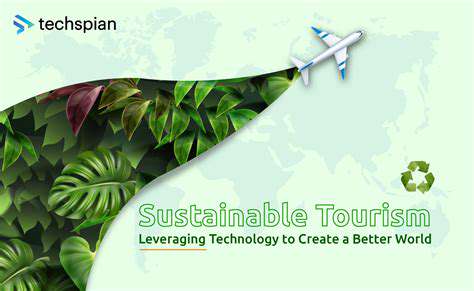Early Voyages and the Quest for Knowledge
Early European Voyages of Exploration
The Age of Exploration, a period spanning roughly from the 15th to the 17th centuries, marked a pivotal shift in human history. Driven by a thirst for new trade routes, the desire to expand European influence, and a burgeoning spirit of scientific inquiry, European explorers embarked on voyages that reshaped the world's geopolitical landscape and dramatically altered the course of global interactions. These voyages, often fraught with peril and hardship, were fueled by a combination of technological advancements, including the development of more robust ships and navigational instruments, and the emergence of powerful, ambitious monarchs who sought to expand their empires and enrich their coffers through trade.
Portugal, with its strategic location and ambitious leadership, played a crucial role in initiating these voyages. Driven by a desire to bypass the established trade routes controlled by Arab and Venetian merchants, Portuguese explorers, like Vasco da Gama, painstakingly charted new sea lanes to India and beyond. Their voyages, while initially focused on finding new trade routes, inadvertently led to the discovery of new lands, cultures, and resources, fundamentally altering the European understanding of the world and ushering in a new era of global interconnectedness. This period of exploration, therefore, was more than just a quest for geographical knowledge; it was a catalyst for profound cultural and economic transformations.
The Impact of Exploration on Knowledge and Understanding
The voyages of discovery had a profound and lasting impact on the European understanding of the world. Exploration brought new knowledge about geography, flora, fauna, and the diverse cultures of the peoples who inhabited the newly encountered lands. The exchange of goods, ideas, and technologies between Europe and the rest of the world, which accelerated dramatically during this period, fostered a process of cultural exchange that had a profound and lasting impact on the development of both societies. This exchange, however, was not always amicable; it often involved exploitation, conflict, and the devastating impact of disease on indigenous populations.
The knowledge gained from these voyages spurred further scientific inquiry and intellectual ferment. The sheer scale of the new information demanded new ways of understanding and organizing the world. Maps became more sophisticated, reflecting the growing awareness of the size and shape of the globe. New scientific instruments and techniques were developed to facilitate navigation and observation. This period of exploration was, therefore, a critical juncture in the development of modern science and geographical knowledge. It laid the groundwork for future voyages of discovery and shaped the modern worldview.
The Age of Exploration and the Expansion of European Influence

The Driving Forces Behind Exploration
The Age of Exploration, a period spanning roughly from the 15th to the 17th centuries, was fueled by a complex interplay of economic, political, and social factors. The insatiable desire for new trade routes to the East, bypassing the established and often costly intermediaries, was a primary motivator. This desire stemmed from the burgeoning demand for Asian spices, silks, and other luxury goods in Europe. This increased demand, coupled with the growing wealth of European powers, created a powerful incentive to find alternative routes.
Beyond economics, the Age of Exploration was also driven by a thirst for knowledge and the expansion of European empires. Explorers, often supported by royal sponsors, sought to chart new territories, claim new lands, and discover new peoples. This drive for geographical discovery, and often the accompanying religious zeal, shaped the course of history. These motivations, often intertwined, shaped the course of European expansion across the globe.
Technological Advancements and Navigation
Crucial to the success of the Age of Exploration were advancements in maritime technology. The development of more sophisticated ships, such as the caravel, with its ability to sail against the wind, allowed explorers to navigate previously inaccessible waters. Improved navigational instruments, like the astrolabe and the compass, enabled mariners to determine their location with greater accuracy, enabling longer voyages and reducing the risk of getting lost.
These advancements in maritime technology were not merely incremental improvements. They represented a fundamental shift in the ability of Europeans to traverse the oceans. This allowed them to reach previously unknown lands and establish new trade routes, fundamentally altering the global landscape.
Impact on Global Trade and Culture
The Age of Exploration profoundly reshaped global trade networks. New routes were established, connecting Europe to Asia, Africa, and the Americas. This facilitated the exchange of goods, ideas, and cultures on an unprecedented scale. The Columbian Exchange, a significant consequence, involved the transfer of plants, animals, and diseases between the Old and New Worlds, dramatically altering both continents.
The exchange dramatically altered societies on both sides of the Atlantic. European colonization led to the exploitation of resources and the subjugation of indigenous populations in the Americas. This period also saw the introduction of new foods, plants, and animals to Europe, fundamentally changing its diet and agriculture. The Age of Exploration, though a period of immense change and expansion, also had devastating consequences for the indigenous populations of newly discovered lands.
Consequences and Lasting Effects
The Age of Exploration had far-reaching consequences that continue to resonate today. The establishment of global trade networks laid the foundation for the interconnected world we know today. The exchange of goods and ideas spurred economic growth and cultural exchange, shaping the world's diverse societies. However, the exploration also resulted in the exploitation and oppression of indigenous peoples in the colonized regions. The legacy of this era continues to be debated and analyzed, highlighting the complexities of historical events and their lasting impact.
The impact on indigenous populations was devastating, with widespread disease, displacement, and cultural destruction. This period is a complex part of history, filled with both progress and tragedy. Understanding this era's complexities is crucial for comprehending the world we live in today.
The Scientific Revolution and the Rise of Geographic Science
The Dawn of Empirical Observation
The Scientific Revolution, a period of profound transformation in the 16th and 17th centuries, fundamentally reshaped the way humans understood the world. Central to this shift was a growing emphasis on empirical observation and experimentation. This new approach, contrasted with the prevailing reliance on ancient authorities and philosophical speculation, paved the way for a more scientific and systematic understanding of the natural world, including the geography of Earth.
Early scientific inquiries into the Earth's features and processes, although not explicitly labeled as geographic science, began to challenge traditional geographical models. Careful observation of natural phenomena like tides, weather patterns, and the distribution of plants and animals became increasingly important in building a more accurate and comprehensive understanding of our planet.
The Role of Exploration in Geographic Knowledge
Exploration voyages, fueled by the desire for trade routes, new lands, and the expansion of empires, played a crucial role in the development of geographic science. These expeditions brought back invaluable data on previously unknown territories, cultures, and resources. Detailed maps, charts, and written accounts of these voyages became essential tools for understanding the world's geography.
Furthermore, the encounters with diverse cultures during these expeditions prompted critical reflection on existing geographical knowledge. Observations of unfamiliar ecosystems, social structures, and political systems challenged Eurocentric perspectives and expanded the scope of geographical inquiry.
The Development of Cartography
Cartography, the art and science of mapmaking, underwent significant advancements during this period. Improved techniques in surveying, astronomy, and map projection allowed for more accurate and detailed representations of the Earth's surface. The invention of the printing press facilitated the widespread dissemination of maps, making geographical knowledge more accessible to a wider audience.
These advancements were crucial in enabling better navigation, facilitating trade, and promoting the expansion of knowledge about different regions of the world. The evolution of mapmaking directly contributed to the growth of geographic science as a field of study.
The Impact of Astronomy on Geographic Understanding
The scientific revolution also saw profound advancements in astronomy, dramatically altering the understanding of the Earth's place in the cosmos. Heliocentric models of the solar system, championed by figures like Copernicus and Galileo, challenged the established geocentric view. This shift in perspective, while not directly related to terrestrial geography, had profound implications for understanding the Earth's position and movement within the universe, influencing the development of accurate celestial navigation and the ability to accurately measure distances.
The Emergence of Geographic Societies
The growing interest in geography led to the formation of specialized societies dedicated to the study and promotion of geographical knowledge. These organizations provided platforms for scholars to share their findings, fostering collaboration and the advancement of the field. The establishment of these societies further solidified geography as a recognized discipline, distinct from other branches of natural philosophy.
These societies played a vital role in standardizing geographical practices, collecting and disseminating geographical data, and establishing a framework for the systematic study of the Earth's features and processes. They also fostered intellectual exchange and critical discussions about geographic phenomena.
The Rise of Geographic Principles
The Scientific Revolution fostered the development of key geographic principles, such as the concept of spatial relationships, the analysis of environmental factors, and the understanding of cultural landscapes. These principles, which continue to form the bedrock of geographic study today, were gradually articulated and refined by various scholars and explorers, who sought to understand the interconnectedness of human societies with their physical surroundings.
The Legacy of the Scientific Revolution in Geographic Thought
The Scientific Revolution laid the groundwork for modern geographic thought. By emphasizing empirical observation, systematic investigation, and the importance of spatial relationships, it established a framework for understanding the Earth's diverse features and processes. This legacy continues to influence geographic research and theory today, shaping our understanding of the world and our place within it.
The principles and methods developed during this period continue to be fundamental to geographical research, from studying climate change to understanding urban development and human-environmental interactions. The scientific revolution significantly shaped the field of geography, creating the foundations for modern geographical inquiry.

Space Exploration and the Quest for Extraterrestrial Knowledge
Early Missions and the Dawn of Exploration
The quest for extraterrestrial knowledge has been a driving force in human history, inspiring countless scientific endeavors. Early space exploration missions, often driven by a combination of national pride and scientific curiosity, laid the groundwork for future endeavors. These initial missions, while sometimes limited in scope and technology, provided invaluable data about our solar system and the conditions necessary for life beyond Earth. They also helped to develop the crucial technologies and infrastructure needed for more ambitious future missions, a testament to the perseverance of the human spirit in pushing the boundaries of our understanding of the cosmos.
The development of rockets and satellite technology during the mid-20th century was pivotal. These advancements allowed for the launching of probes and satellites, enabling us to gather data from distant planets and celestial bodies. The early missions, often focused on planetary flybys and orbiters, provided crucial images and data that helped us understand the composition, structure, and potential habitability of these worlds. The scientific discoveries from these early missions sparked a renewed interest in space exploration, fueling the desire for further, more detailed investigations.
Unveiling the Mysteries of the Solar System
As our understanding of space travel and technology improved, so did our ability to explore the solar system in greater detail. Missions like the Viking program to Mars, the Voyager probes' grand tour of the outer planets, and the Hubble Space Telescope's observations from orbit have provided us with a wealth of information about the planets, moons, and asteroids that populate our cosmic neighborhood. These missions have uncovered evidence of past or present water activity, explored the possibility of subsurface oceans on icy moons, and offered insights into the formation and evolution of our solar system.
The discoveries of complex organic molecules on asteroids and the presence of potential biomarkers on some planetary surfaces have fueled the search for extraterrestrial life. These findings have significantly advanced our understanding of the potential for life beyond Earth, pushing the boundaries of our knowledge and imagination. The exploration of the solar system has yielded a vast trove of data, revealing a diverse and dynamic universe, and has further strengthened our understanding of the origins of our own planet and the universe as a whole.
The Search for Habitable Worlds and Beyond
The quest for extraterrestrial knowledge has expanded beyond our immediate solar system. Modern space exploration missions are increasingly focused on identifying and characterizing exoplanets—planets orbiting stars other than our Sun. The discovery of potentially habitable exoplanets in the Goldilocks zone – the region around a star where liquid water could exist on a planet's surface – has generated immense excitement and renewed hope in the search for life beyond Earth. Scientists are developing new technologies and refining existing techniques to study these distant worlds, searching for signs of life through atmospheric analysis and other methods.
Beyond the search for habitable worlds, space exploration is pushing the boundaries of our understanding of the universe itself. The study of dark matter and dark energy, the exploration of distant galaxies, and the search for the origins of the cosmos are all part of this ongoing quest. These endeavors, often involving international collaborations and the development of sophisticated instruments, are driving innovation and inspiring future generations of scientists and engineers. The future of space exploration promises even more profound discoveries and a deeper understanding of our place in the vastness of the cosmos.











